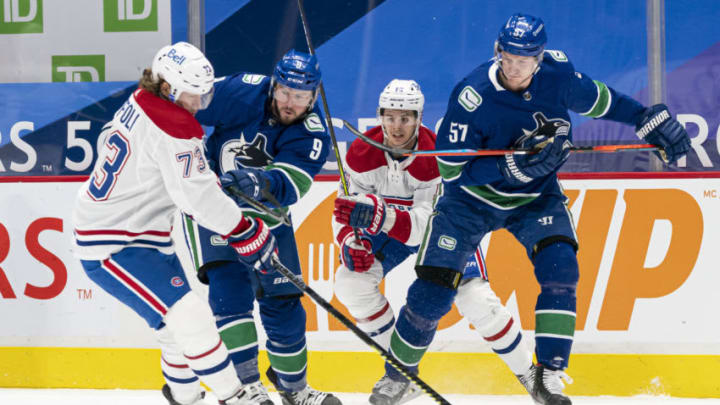Canucks: How do they compare to the Montreal Canadiens? (Part 3)

Again, let’s go back to the on-paper analysis for this factor.
At the beginning of the season, the Canucks appeared to have a fairly strong group of blueliners, both offensively and defensively. Schmidt brought versatility, being able to play on both sides, Edler and Myers had decent outings in training camp, and Hughes was poised to build off of his impressive rookie campaign.
But, for whatever reason, their group was unable to find or maintain any sort of chemistry, forcing Green to often put his defensive pairings in a blender. Whether it was due to sporadic point production, poor defensive fundamentals, or nagging injuries, the Canucks’ coaching staff were never able to lock down three defensive duos that they felt comfortable rolling out on a nightly basis, and it was evident on the ice.
Part of this can be traced back to the departure of Chris Tanev.
Tanev was a staple on the right side of the Canucks’ blueline for close to a decade. Most recently, during the 2019-20 season, he found instant chemistry with Hughes, and the two of them formed one of the stronger defensive pairings on the team as a result. Hughes was able to showcase his explosive speed and offensive creativity, while Tanev made sure to lock things down defensively if the opponents countered.
In hindsight, yes, it was probably better that the team didn’t commit to Tanev long-term. He had a good first outing in Calgary, but there’s a high chance that the Flames will regret the last year (or two) of that contract, and the Canucks didn’t need to be bogged down with yet another regrettable long-term deal.
The Canucks were also able to find a suitable replacement for Tanev in the offseason in Hamonic. Hamonic did struggle with injury at first, but eventually seemed to find his rhythm with Hughes in the latter half of the season. Unfortunately, that rhythm didn’t appear to have the same effect as the Hughes-Tanev duo. Maybe it was just due to a small sample size in a shortened season, but it still left even more questions about what to do on the right-side for the defence moving forward.
Because of these factors, Green was often forced to roll out different defensive pairings each game. He juggled Hughes, Edler, Myers and Schmidt in the top-four while Hamonic was injured, and had to balance all five when Hamonic was healthy. Green also had to go back and forth between Juolevi and fellow-rookie Jalen Chatfield to fill in the bottom pairing.
All of this really caused a problem for the Canucks.
As a result, their defencemen struggled with positioning and communication, and often had trouble completing outlet passes, carrying the puck out of their own end and gaining momentum in the neutral zone. They were also unable to send out a strong, reliable shutdown pairing when needed, something the team has struggled with since the combination of Dan Hamhuis and Kevin Bieksa back in 2011.
This didn’t effect Montreal nearly as much, as both Claude Julien and Dominique Ducharme were always confident in sending out their three pairings. Both coaches were also able to use either Weber or Petry on the right side, as well as Chiarot or Edmundson on the left, for their shutdown combinations.
And, as expected, when you experiment with different defensive pairings at even strength, it’ll also happen on the penalty kill, too.
This leads us to the second factor – special teams.